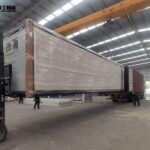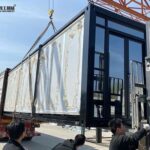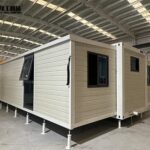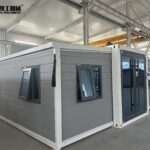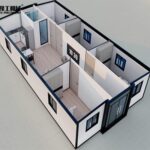Portable prefab house is a pre-engineered, modular dwelling unit designed for easy transportation, rapid assembly, and reuse. Unlike traditional homes built on-site, these structures are manufactured in factories, where precision engineering ensures quality and consistency. The term “portable” highlights their ability to be relocated, while “prefab” (short for prefabricated) refers to their off-site construction. Amidst challenges like housing shortages, escalating construction costs, the need for disaster relief shelters, and a growing desire for flexible living and working spaces, a remarkable innovation stands out: The portable prefab homes, particularly those featuring advanced folding or collapsible designs.
Features of Portable Prefab House
- Foldable or Collapsible Design: Many models collapse into compact units for efficient shipping.
- Modular Components: Walls, floors, and roofs are pre-assembled, allowing for quick installation.
- Customizability: Buyers can choose layouts, finishes, and add-ons like insulation or solar panels.
- Durability: Built with steel frames and weather-resistant materials, they withstand harsh conditions.
- Eco-Friendliness: Recyclable materials and energy-efficient designs reduce environmental impact.
Why Foldable Prefab Houses Are Gaining Popularity
- Speed of Deployment
Traditional construction can take months or years. Portable prefab house, however, can be installed in as little as a few hours to a few days. This rapid deployment is critical for emergency shelters, disaster relief, and time-sensitive projects. - Cost Efficiency
Factory production reduces labor costs and material waste. Studies show that prefab homes can be cheaper than conventional builds, making them ideal for budget-conscious buyers or organizations. - Mobility and Flexibility
Whether you need temporary housing for a construction site, a remote office, or a vacation home, portable units can be relocated. This adaptability eliminates the need for permanent foundations, saving both time and resources.
Applications of Expandable Prefab Home
- Emergency and Disaster Relief
After natural disasters like earthquakes or floods, portable units provide immediate shelter. - Affordable Housing
Governments and NGOs are adopting portable prefab houses to tackle housing crises. Their scalability and low cost make them viable for low-income communities and refugee camps. - Commercial Spaces
Businesses use portable units as offices, retail kiosks, or pop-up stores. Their modular design allows for easy expansion as companies grow. - Construction Site Accommodation
Contractors use portable units as on-site offices, dormitories, or canteens, ensuring worker comfort and productivity.
Advantages of Prefab Container Houses
- Cost-Effective
The streamlined production and minimal labor requirements drastically reduce the overall cost compared to conventional buildings. Mass production also allows manufacturers to lower prices per unit, making it a budget-friendly solution. - Mobility and Reusability
One of the biggest selling points is mobility. A portable prefab house can be relocated, reused, and reinstalled, which is particularly advantageous for temporary housing needs, mobile offices, and remote workstations. - Customization Options
Modern portable prefab homes offer a variety of customization options, including interior layouts, color schemes, materials, etc. Whether used as a family home, office, classroom, or medical unit, it can be tailored to meet specific needs.


